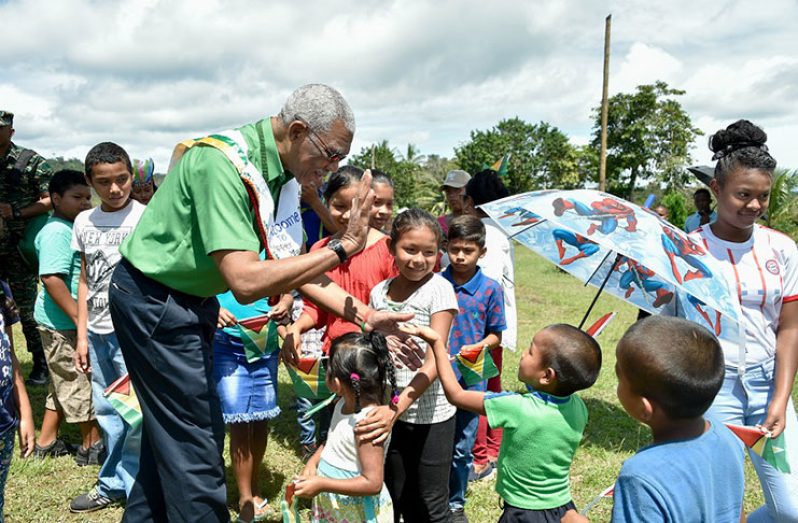IN August 2015, three months after entering office, President David Granger unveiled a Ten-point Plan of Action for Hinterland Development, which strategically aims to reduce the inequalities between the hinterland and the coastland, by providing better infrastructure and a better quality of life. The first point on the list concerns education.
In Guyana, the month of September is designated Indigenous Heritage Month as well as Education Month. While President Granger holds both occasions in high regard, he prioritises education as the catalyst for development.
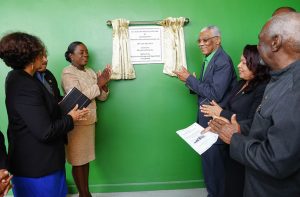
In his address at the launching of Amerindian Heritage Month, on September 1, 2019, at the Sophia Exhibition Centre, Georgetown, the President described education as “the cornerstone of Government’s plans to ensure greater equality between the hinterland and the coastland, to reduce poverty and to provide greater economic and employment opportunities for Indigenous communities”.
He said his government inherited an education system beleaguered with several challenges and that hinterland schools and dorms were in a “sad state,” plagued by substance abuse, interpersonal violence, bad infrastructure, poor sanitation, the absence of potable water, among other ills.
President Granger on that occasion, also emphasised that “Parents and residents no longer need to protest against the conditions at Hinterland dormitories and schools”. Further, he said, “students feel safer and are more comfortable because of the interventions and improvements which have been made,” since his Government assumed office in 2015.
Investing in education
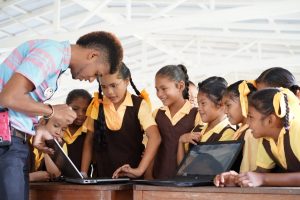
“[The] investment in infrastructure and Information Technology, the expansion of [the] school feeding scheme and the provision of transportation and scholarships have all helped to reduce the number of hinterland school dropouts from 10 Primary School students per week in 2014 to an average of three students per week in 2017, an average of 17 secondary school students dropped out weekly from hinterland schools in 2014, this has dropped to five per week in 2017,” President Granger informed during his address at the September launch. The Head of State asserted that “Hinterland education, therefore, is being established on a firm footing,” and will continue to be prioritised in what he has described as a new Decade of Development, spanning from the year 2020 to 2029.
In 2019, the Ministry of Education commissioned five schools in the hinterland. In February, two nursery schools were commissioned in Upper Takutu-Upper Essequibo (Region Nine), one at Parikwaranau, and another at Tabatinga. In March, a secondary school was commissioned at Kato, Potaro-Siparuni (Region Eight) and in September two new schools were commissioned in Cuyuni – Mazaruni (Region Seven), one at Kamarang and another at Paruima.
Access to Information and Communication Technology (ICT) has also been boosted as a result of the establishment of ICT Hubs. A total of 17 ICT hubs were established in several communities spread across Barima-Waini, (Region One); Cuyuni – Mazaruni (Region Seven); Potaro – Siparuni (Region Eight) and Upper Takutu – Upper Essequibo (Region Nine).
A smart classroom was commissioned at the Lethem Learning Resource Centre at the Tabatinga Annex, Upper Takutu-Upper Essequibo (Region Nine) and over 20,000 students from 216 hinterland nursery and primary schools benefited from school feeding programmes.
In addition to upgraded schools and healthy meals, the Government introduced the Public Education and Transportation Service (PETS) in the hinterland, since navigating through the rough terrain and the long distances between homes and schools were among the main deterrents to school attendance.
Government through PETS, formally known as the Five Bs initiative, handed over eight boats and a similar number of buses to several Indigenous communities, to provide hassle-free transportation for school children.
Equal access to education
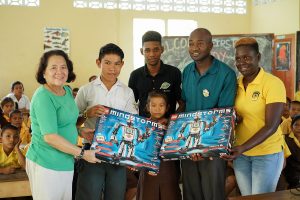
President Granger assured that the new Decade of Development will ensure that there is free, easy and equal access to education for all. “The decade will restore free education as an entitlement as mandated by our Constitution which states every citizen has the right to free education from Nursery to University…. Indigenous people can be assured that they will not be left behind when petroleum production commences next year, they can be assured that the national natural resources will be developed in a manner to ensure greater equality between the Hinterland and Coastland,” the President said.
Since taking office, the Government has also increased the number of scholarships given out to hinterland students by 41 per cent, moving it from 110 scholarships in 2014 to 187 in 2018. Students who either needed to leave the hinterland to study on the coastland or leave their village to study in another hinterland village, also now enjoy better accommodations.
Thirteen-year-old Master Julius Marks of Port Kaituma, Barima-Waini (Region One), gained a Government scholarship to attend the Brickdam Secondary School in 2017. He now resides at the Hinterland Students Dormitory at Liliendaal, East Coast Demerara. According to the young man, being given the opportunity to study in Georgetown made him feel special.
“For me it’s a great privilege because since I was small, I wanted to become a physician and now that I have the opportunity to pursue my dream, it makes me feel happy … I would like to encourage other persons living in the Hinterland, to study hard so that one day they could be here,” Julius told the Public Information and Press Service (PIPS) Unit of the Ministry of the Presidency.
Meanwhile, for thirteen-year-old Miss Anasie Fredericks of Tapakuma Village, Pomeroon-Supenaam (Region Two), it is a “life-changing” experience to be given the opportunity to attend the Bishops’ High School.
“I’m thankful that the Ministry has provided this scholarship [and] the opportunity for a better education. So far, I’m really enjoying it … I would like to continue from Secondary School onto University and I hope to become a Magistrate, so I hope to study law,” Ms. Fredericks said.
Preparing for advance technology
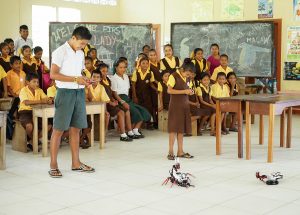
In addition to President Granger’s dedication to Hinterland Development, First Lady, Mrs. Sandra Granger has been contributing significantly to this cause.
This year, through her Information and Communication Technology (ICT) Workshops, Mrs. Granger has certified a total of 148 Hinterland residents in ICT and trained a total of 98 Hinterland children in Robotics. Barima-Waini (Region One), Cuyuni-Mazaruni (Region Seven), Potaro-Siparuni (Region Eight) and Upper Takutu – Upper Essequibo (Region Nine) were targeted.
“This ties in with my husband’s concept on education. Education has to be relevant and the children of today will require education in ICT; this is what everybody calls the fourth industrial revolution. You have to know ICT…I mean already you have drones in agriculture, you have, artificial intelligence in medicine, in manufacturing, in everything… especially when you think of where Guyana is now and where we want it to be. I think we owe it to our young people to train them so that they know they can be very comfortable in the world of ICT,” Mrs. Granger said during an interview with PIPS last year.
Additionally, 46 adolescent and out-of-school youths from 14 communities in Cuyuni-Mazaruni (Region Seven) participated in the First Lady’s last ICT Workshop, which was held in July this year.
Participant of that workshop, Ms. Barbalee John, speaking on behalf of her colleagues, had said that they were now excited about technology and its use in the community as well as its use in business development.
“We are now confident to work and develop our communities and our country … I want to say that we the youths of Upper- Mazaruni will become successful business owners and I have learnt that as business persons we sell solutions,” Ms. John had said.
As Guyana continues on its path of growth and development, Government’s focus continues to be on ‘an education nation’ and ensuring equitable development in the sector countrywide.



.jpg)





